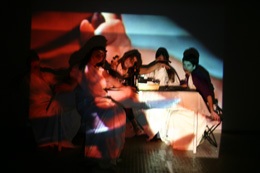
The final exhibition of the installation art class took place at ECLA in the last week of the winter term. Installations addressed themes such as trust, fantasy, change and the passage of time, vanity and power relations. I had the opportunity to act in the installation entitled ‘The Last Supper’ by Lia Tarkhan-Mouravi (Georgia, Academy Year 2007) and experience installation art from the performer’s perspective.
In the words of its author, ‘The Last Supper’ expressed “the transformation that occurs in art when a certain motif is depicted exhaustively”. Aiming to place her work in the context of ECLA, Lia chose the iconic Last Supper to reflect upon our academic focus on the Renaissance. Because viewers were exposed to images touching upon this particular biblical scene throughout the term they immediately recognized the scene played out before them. Nevertheless, some aspects were quite different from what is customary: instead of twelve male apostles there were six women and cigarettes took the place of the loaf.
“I wanted women to be the centre of attention and this is why six women replace twelve men” said Lia. “To the ancients bread was a necessity, but ironically, in our society cigarettes are a sort of necessary bread”. Moreover, in contrast to the pious apostles in the Renaissance paintings, our lady apostles laughed, smoked, drank wine, talked loudly and celebrated the gathering.
While most people engaged in the scene from afar, those who ventured to come closer and ask us questions soon understood we only offered responses befitting our characters. Lia hoped viewers would feel the urge to sit at the table and grab a glass or a cigarette, which some of them actually did. Incidentally, a small accident added meaning to the artwork – a spilt glass of wine dripping from the tablecloth onto the floor was interpreted as symbolizing blood. “What is interesting about depicting biblical scenes is that all elements are understood as bearing a hidden message, even those things that would otherwise be obviously coincidental”.
After the exhibition time ran out, we still felt like lingering with our wine and discussion at the table. I must confess that the symbolist tension of the piece made us feel uneasy at times; nevertheless we were able to overcome this and continue performing in a piece of artwork. I was quite impressed by the scene, perhaps even to a greater degree than I would normally respond as a viewer. Wrapped up in the discussion, both the grandiose and petty gestures of my fellow performers seemed to embody undecipherable meanings. “I had no idea how the performers would interact, but somehow, with all the spontaneity it worked out perfectly by itself” concluded Lia.
By Clara Sigheti (AY 2007, Romania)
